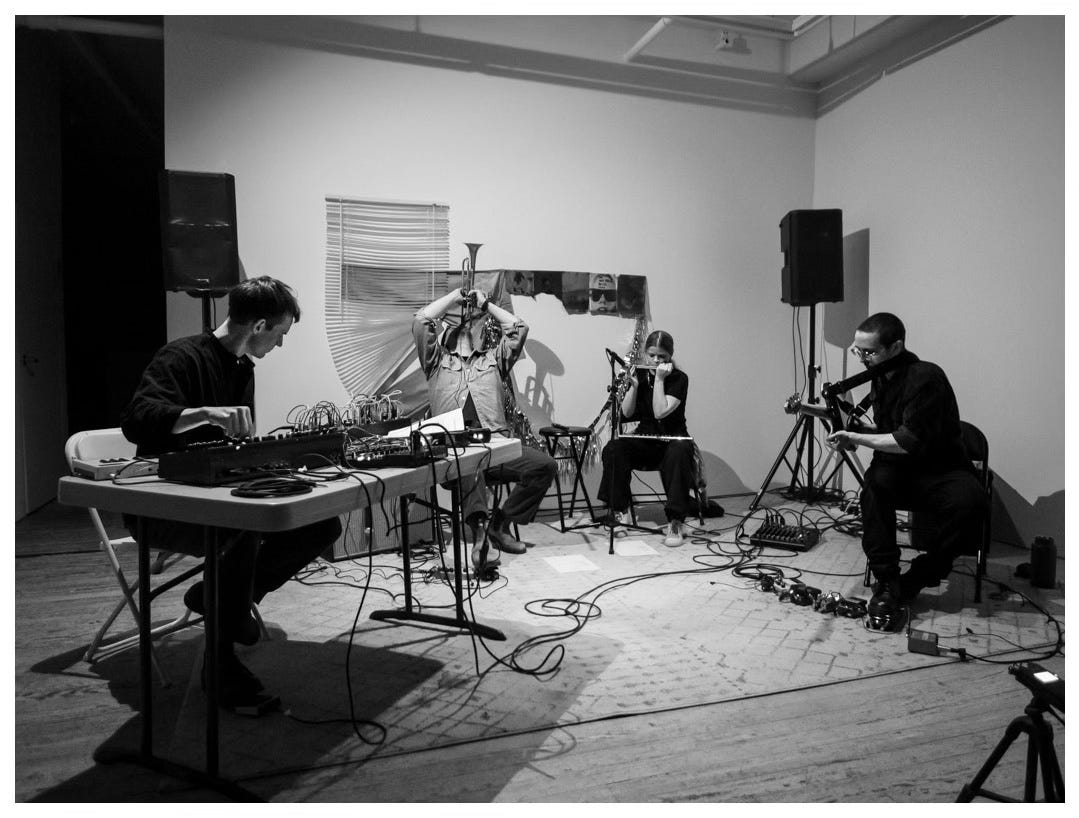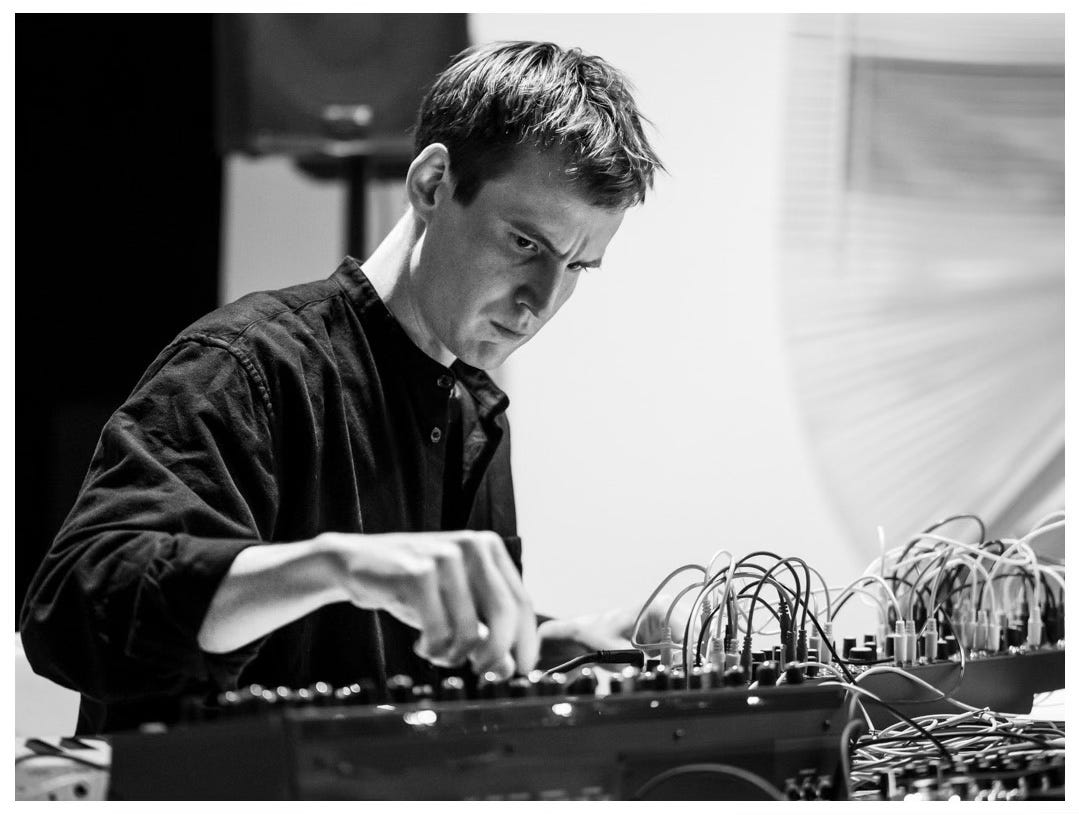Prepare for Movement (or, Two Bows Better Than One)
C. Spencer Yeh shreds on violin and four musicians team up for a premiere at Microscope Gallery
A flute is a flute is a flute, unless it’s played by Laura Cocks; then, it’s a punching bag, another appendage, and a smartphone charging port that you’re trying to blow the dust out of, all in one.
A trumpet is a trumpet, unless it’s played by Nate Wooley; then, it’s a tube to a sonic multiverse heretofore unknown.
A guitar is Aaron Rubinstein; or, at least it appears that way when he hoists it up in front of his face and puts his mouth on its body and soundhole (and sings into it?), becoming a literal GuitarHead.
A synthesizer, as I experienced it last Monday, can sound like all of these instruments, and their incarnations, to the point that you don’t know who’s playing what, especially when that synth is in the hands of Elias Stemeseder.

On the evening of January 7, these four musicians got together at Microscope Gallery, near Hudson Yards, to premiere a composition that Rubinstein wrote with them in mind called Movement in Preparation. The performance was the gallery’s first event of 2024, three years after it had moved from its original Bushwick location, and fourteen years after its founding by Elle Burchill and Andrea Monti.
So named for the poet and cultural theorist Fred Moten’s idea of “a struggle toward language that tries to struggle toward things… a movement in preparation,” the piece, Rubinstein told me, involves the musicians “centering and setting up a way of playing that engages with thresholds and conviviality as opportunities for exercising faith and, in that, struggles toward the struggle.”1 Now that may feel like reading Heidegger, but I take it to mean that the struggle to say what one means, to express oneself, is the very process that Rubinstein aims to show with sound. Always preparing, never getting there. Musical freedom is, after all, a constant struggle.
Rubinstein dedicated the piece to Moten and Éliane Radigue, the French pioneer of electronic music.
For the listener, Movement in Preparation really does come down to a struggle. And that is the struggle to tell who’s playing what.
The whole 45-minute performance was governed by intermittent swells. Long, glacial dissonances and gentle drones compounded and subsided, until the whole piece disappeared with a long decrescendo.
Stemeseder, usually a pianist, switched on deep, ear-rattling drones and manipulated them with a small midi keyboard. Robust, swollen, electronic clicking ensued, approaching a consistent rhythm. Wooley closed his eyes and blew into his amplified trumpet, which had no mouthpiece. I tried to parse what sound he was making, but it was either so soft or so similar to what else was going on, that I couldn’t figure it out. At times, he put his palm onto the mouth-piece-less blow hole, maybe preventing feedback or conjuring a reverse-muted sound, as the music around him reverberated through his trumpet. But that really is just a guess. Sometimes he held his trumpet vertical, close to the ground, with the bell just above the floor.
Both Wooley and Rubinstein took turns raising their heads to look at the ceiling, craning their neck for longer-than-comfortable durations. Rubinstein scratched on his electric guitar strings at first, but soon began to slowly lift the instrument to his face and then oscillated toward the musicians and the audience, like the guitar was some sort of satellite seeking out a signal. He flipped it both ways, sometimes putting the strings to his mouth, other times placing the back of the body to his lips. I saw him taking deep breaths in and out, but he didn’t seem to be making any drastically different sounds from Wooley and Stemeseder.
Asking him what he was doing would be like asking a comedian to explain a joke. So I didn’t, and haven’t.
Cocks, to my ears, was the only musician whose contribution I could pick out from the ensemble. They undid and replaced the headjoint and footjoint of their flute, blew into the bottom of the tube, whacked the keys in angry, airy trills, and put a palm to the end of the instrument in a similar way to Wooley. Again, as a listener, I’m not sure what this last technique did to the sound. But Cocks was an essential source of ornamentation to oppose the otherwise heavy, almost stale sound of the musicians around them.
Now, I don’t want to know why anyone did any of the things they did, regardless of if I could tell how they were contributing to the sound or not.
Or, at least I don’t want anyone to tell me.
That’s because the main point, for me, of performances like this — the fun — is figuring out what the musicians are doing and why they’re doing it. That seems to me to be one of the main ways (in addition to closing one’s eyes and meditating) an audience member can get pleasure out of these types concerts.
But I had trouble with this one. Mainly because they all blended together so well that they sounded like one instrument, which is usually a compliment, but in this case annoyed me a bit. Looking back on the performance, I appreciate the gestalt sound that Rubinstein conjured through these brilliant players. But during the actual performance, it was, for me, another instance of, “What about the audience?”, a question I asked of Wadada Leo Smith in a review I wrote in September. So, I guess I felt a little left out.
But maybe that’s a me problem.
There was also a seriousness about Movement in Preparation that made my attention waver. You see it a lot in improvisatory, experimental, avant-garde music here in New York. Maybe it’s because the musicians are focusing so hard on what they want to improvise. But there is an air of sadness with it all. Sadness at what? It doesn’t seem to me that there’s any latent or explicit emotional or narrative content in this music. Is that sad in itself? I couldn’t put my finger on any emotion that this music expressed, except for maybe aggressive ones, like anger, frustration, resentment. Just look at Cocks’s flute playing, where they actually hit the keys like a cat swatting at a bug that’s getting away.
I love when experimental musicians recognize that what they’re doing is really hilarious when it comes down to it. I don’t need to explain it to you. Some of the best recognize this humor. Shelley Hirsch, Fast Forward, Kathleen Supové, most musicians at Roulette on November 13 of last year. If you defamiliarize the performance, and look at it like you’re a child seeing it for the first time — which is what the Russian Formalist literary critic, Victor Shklovsky, thought was at the root of Tolstoy’s genius — you realize what you’re hearing and seeing is really bullshit, as the composer Theo Haber put it to me at a party last weekend. And I mean that in the best way possible, really. It’s only irritating when the musicians don’t recognize that it’s all bullshit.
Haber, again: “[When] the composer takes it too seriously and [the performance] thus becomes some weird meta moment where you are no longer engaged with the performance but with the strange act of perceiving someone take themselves way too seriously,” that’s when it becomes “absurd.”
That’s all to say I want to see this quartet get together again.
The First Half
The first half C. Spencer Yeh had all to himself. With amplified violin, Yeh started off bowing close to — and, it appeared, on — the bridge, while he pattered a creepy-crawly left hand up and down the neck, making caustic, scratchy portamento. His fingers, spiderly, tapped the strings. The amplification caused the violin to sound like more than just one instrument. At times, his fingering was so quick that it almost sounded like — this was illusory, of course — I could hear excerpts of would-be famous classical compositions. Doubtless these were illusory, but the collaging of patterns Yeh conjured took the imagination on a trip around the world in improvised musical phrases that signified nothing outside of themselves.
He then brought out a second bow, using that one in his left hand to scratch over the neck. This doubled the effect, with the hollow sound of the body of the violin sounding like ambient winding blowing over microphones in a desert. The whooping and whooshing this created started to sound like heartbeats. The bass end of the instrument swelled into an almost unbearable loudness. This went on for about a half hour.
Yeh hesitated to end, but when he did, he said, “Okay, thank you.” And everybody laughed.
That’s what I’m talking about.
A few minutes later, he walked down the gallery hall to get a drink of water. He splashed some sink water in his face and in his mouth. Elle Burchill ran over, astonished: “We have water for you!”
“I know,” he said, “I just had some!”
Everyone cracked up. Burchill said no one had used the sink for six years. More laughs.
That, also, is what I’m talking about.
Fred Moten, B Jenkins (Duke University Press 2010), 99.







